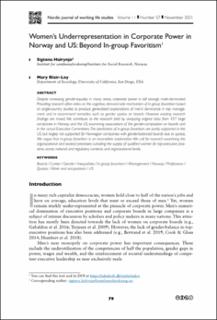| dc.contributor.author | Halrynjo, Sigtona | |
| dc.contributor.author | Blair-Loy, Mary | |
| dc.date.accessioned | 2022-01-04T07:25:05Z | |
| dc.date.available | 2022-01-04T07:25:05Z | |
| dc.date.issued | 2021 | |
| dc.identifier.citation | Nordic Journal of Working Life Studies 2021;11 (S7) 79-102 | en_US |
| dc.identifier.issn | 2245-0157 | |
| dc.identifier.uri | https://hdl.handle.net/11250/2835900 | |
| dc.description.abstract | Despite increasing gender-equality in many areas, corporate power is still strongly male-dominated. Prevailing research often relies on the cognitive, demand-side mechanism of in-group favoritism based on single-country studies to produce generalized explanations of men’s dominance in top management and to recommend remedies, such as gender quotas on boards. However, existing research findings are mixed. We contribute to the research field by analyzing original data from 457 large companies in Norway and the US, examining associations of the gender-composition on boards and in the actual Executive Committees. The predictions of in-group favoritism are partly supported in the US, but largely not supported for Norwegian companies with gender-balanced boards due to quotas. We argue that in-group favoritism is an incomplete explanation. We call for research examining the organizational and societal processes curtailing the supply of qualified women for top-executive positions, across national and regulatory contexts and organizational levels. | en_US |
| dc.language.iso | eng | en_US |
| dc.rights | Navngivelse-Ikkekommersiell-DelPåSammeVilkår 4.0 Internasjonal | * |
| dc.rights.uri | http://creativecommons.org/licenses/by-nc-sa/4.0/deed.no | * |
| dc.title | Women’s Underrepresentation in Corporate Power in Norway and US: Beyond In-group Favoritism | en_US |
| dc.type | Journal article | en_US |

